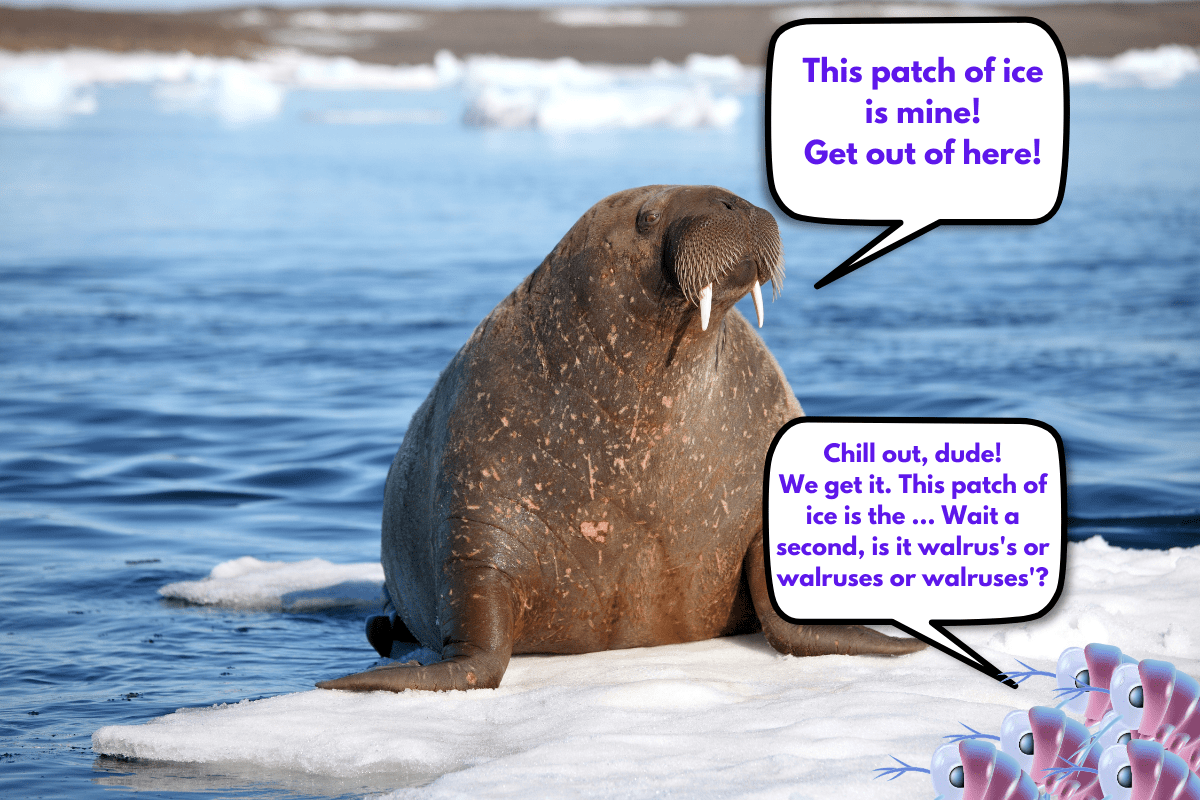Ah, the humble walrus swimming with its fellow marine mammals in the vast and wonderful ocean. But have you ever wondered about the possessive form of this amazing animal? Is it “walrus’s,” “walruses,” or “walruses'”? Let’s look at this grammatical conundrum and find out once and for all!
Table of Contents
What Is the Grammatically Correct Possessive Form of Walrus?
The singular possessive form of walrus is “walrus’s.” The plural form of walrus is “walruses,” and the plural possessive form of walrus is “walruses’.” When referring to a single walrus, the possessive should be expressed as “walrus’s”; when referring to multiple walruses, it should be “walruses’.”
What Does Walrus Mean?
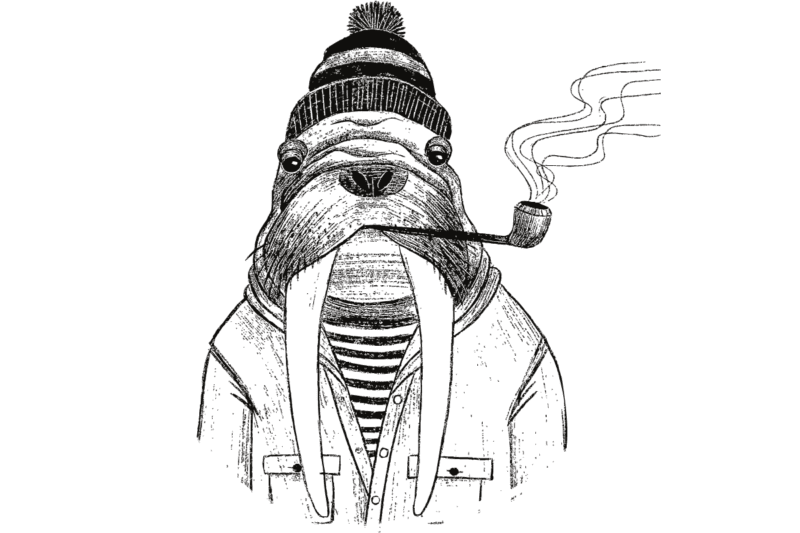
A walrus is a large, semi-aquatic mammal that is part of the Pinniped order, along with seals and sea lions. Walruses are known for their remarkable tusk-like canine teeth, which grow prominently from the upper part of their jaw.
They’re also quite large, with adult males weighing up to 2 tons or more and females exceeding 1 ton! Clearly not something you want to mess with.
Walruses live mainly in the frigid waters of the Arctic Ocean and are usually found near the coasts of Alaska, Canada, Russia, Greenland, and Norway.
The word “walrus” is believed to have started as the Old Norse word “rosmhvalr,” meaning “horse-whale,” likely because it was so big and weird-looking.
Over time, “rosmhvalr” evolved into “hrosshvalr” in Old Icelandic and “rostkalv” in Old Norwegian before becoming “walrus” in Dutch.
Finally, it is believed to have been adopted into English sometime around the 1650s.
Singular Possessive of Walrus: Walrus’s
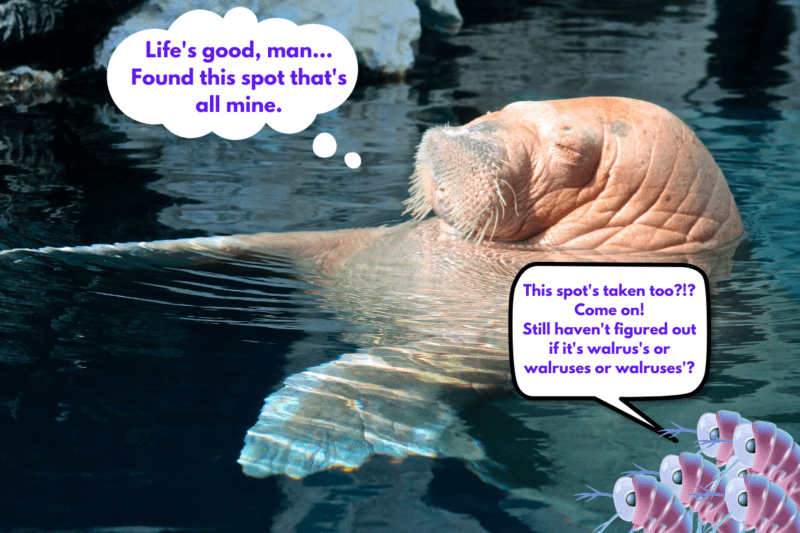
First, let’s establish the rules for forming the possessive form of singular nouns. If the noun is singular, you add an apostrophe and an “s” to the end of the word. For example, “the flower’s petals” or “the phone’s screen.”
But what about nouns that do end in “s,” like walrus? Well, this is where things get a bit murky. The most widely accepted rule is to add an apostrophe and an “s” to form the possessive, as in “the walrus’s habitat.”
However, some people prefer to drop the “s” and simply use the apostrophe, as in “the walrus’ size.”
Both are grudgingly considered correct, but it’s best to check the style guide of the publication or organization you’re writing for to see which they prefer.
And if you can’t find any clear guidance, stick to what most experts agree with, namely “walrus’s.”
If you’re confused about other animals and their possessive forms, check out this article on the possessive form of turkey. You’ll also discover the fascinating story of why a bird is named after a country.
Now, let’s look at some examples of how to use the singular possessive of walrus in a sentence:
The walrus’s whiskers were covered in ice after swimming in the frigid Arctic waters.
I couldn’t believe my luck when I found a walrus’s tooth on the beach.
We watched the walrus’s behavior as it sunbathed on the rocky shore.
The biologist’s study of the walrus’s diet revealed some surprising findings.
Is Walrus’s Always Indicative of Singular Possessive?
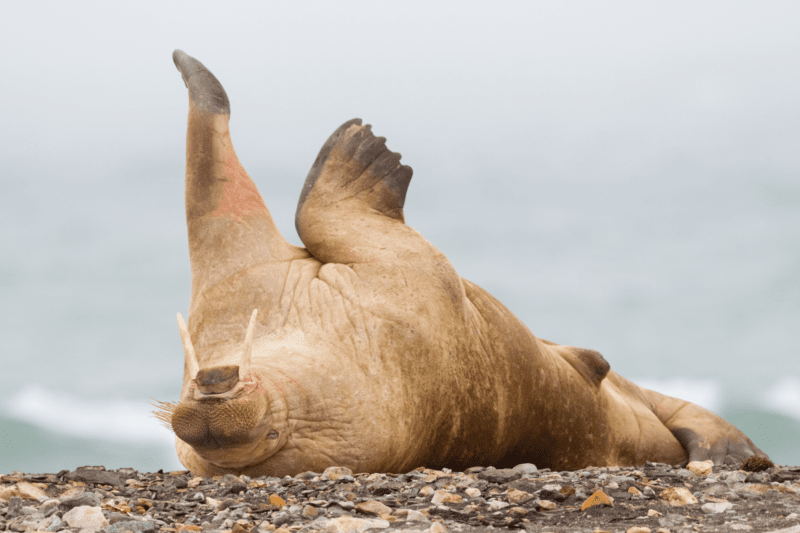
“Walrus’s” can indicate singular possessive or act as a contraction for “walrus is”. Unfortunately, English grammar can be confusing in this regard.
To form the singular possessive of walrus, you must add an apostrophe and an “s” to the end of the noun. This indicates that something belongs to a single walrus, such as its habitat or tusks.
On the other hand, “walrus’s” can also act as a contraction for “walrus is.” An excellent example of this would be:
I’m not sure if the walrus’s hungry or just lazy.
In this sentence, “walrus’s” is a contraction for “walrus is,” which you can tell because if you replaced the former with the latter, the sentence would still make sense.
I’m not sure if the walrus is hungry or just lazy.
While contractions like these may be appropriate for more casual writing, it’s generally best to avoid them when writing formally, like in an essay.
However, even in casual writing, this particular contraction can confuse readers and disrupt their engagement with your writing, so try to avoid it as much as possible.
Plural Form of Walrus: Walruses
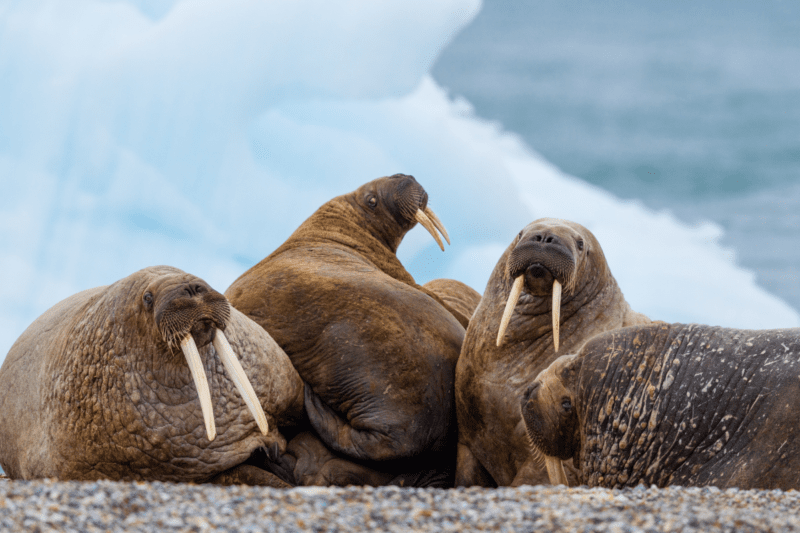
So, we know what a single walrus is, but what if there are more of them? What’s the plural form of walrus? Like most English nouns that end in “s,” you form the plural of walrus by adding “es” to the end of the word. In other words, the plural of “walrus” is “walruses.”
Here are some examples of using “walruses” in a sentence:
The walruses looked a little grumpy at being disturbed.
The walruses had been gathering at this spot for days.
The researchers were amazed to find so many walruses in the area.
We watched as the walruses played in the shallow waters.
And here’s a fascinating little tidbit.
A group of walruses is called a pod, a huddle, or a herd. Depending on their size, a herd of walruses can contain anywhere from tens to hundreds of individuals!
Here are some examples:
The pod of walruses was so large that it took up the entire beach.
The huddle of walruses snuggled together for warmth in the cold ocean waters.
We couldn’t believe our eyes when we saw the herd of walruses.
Plural Possessive Form of Walrus: Walruses’
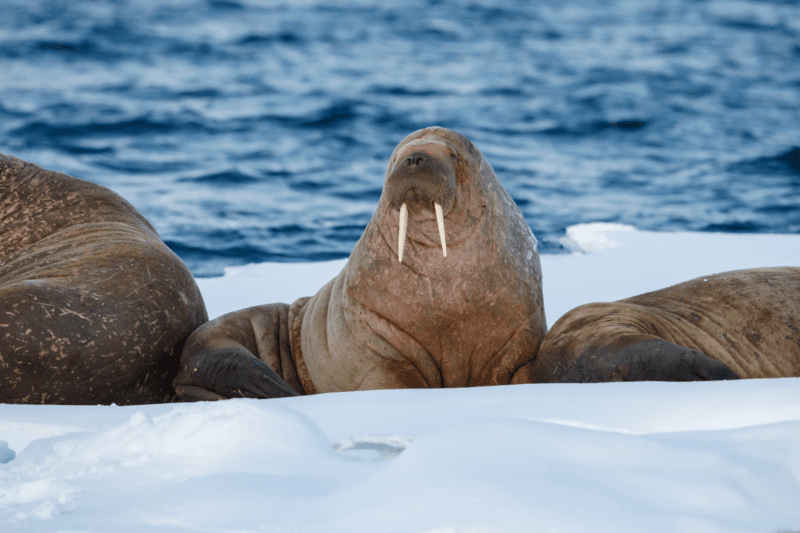
Now that we know what the plural form of walrus is, namely “walruses,” let’s see how to form the plural possessive form.
The plural possessive of walruses is formed by adding an apostrophe and an “s” to the end of the word. So, the plural possessive of walrus is “walruses’.”
Here are some examples:
The walruses’ tusks glinted in the sun.
We watched as the walruses’ calves followed their parents into the sea.
The walruses’ cries echoed through the foggy morning air.
This proved that the walruses’ population had increased steadily in recent years.
In all these examples, the plural possessive form shows that something belongs to multiple walruses.
So, why isn’t it “walruses’s”, you ask?
Besides the mind-bending succession of so many “s”es, the rule in English is that the plural possessive form of a noun ending in “s” does not require another one. And we are very grateful for it because that’s just one too many “s”es.
Ready to Take on the Walrus?
Now that you know the singular and plural forms of “walrus” and how to form their possessive forms, you’re ready to take on writing about walruses.
Whether you’re talking about one or many, just remember: when it comes to the possessive, add an apostrophe, an “s” for singular, and just an apostrophe for plural.
So, now that you can take on the walrus – just the word, mind you – go forth and write with confidence!

